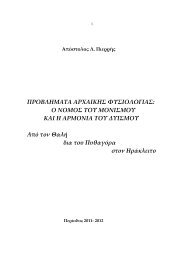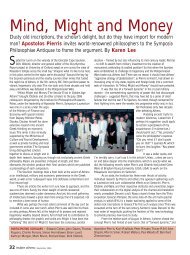APPENDIX C΄ ON DEPILATION: BODY COSMETICS IN CLASSICAL ...
APPENDIX C΄ ON DEPILATION: BODY COSMETICS IN CLASSICAL ...
APPENDIX C΄ ON DEPILATION: BODY COSMETICS IN CLASSICAL ...
Create successful ePaper yourself
Turn your PDF publications into a flip-book with our unique Google optimized e-Paper software.
<strong>ON</strong> DEPILATI<strong>ON</strong>: <strong>BODY</strong> <strong>COSMETICS</strong> <strong>IN</strong> <strong>CLASSICAL</strong> ANTIQUITY 559<br />
appleÏÂÖÛÙÔ˜ àÓıÚÒappleˆÓ ù¯ÏÔ˜,<br />
¬ÛÔ˜ Ôé‰ÂappleÒappleÔÙ’ qÏı’ àıÚfiÔ˜ ☠ÙcÓ apple‡ÎÓ·.<br />
ηd ‰ÉÙ· apple¿ÓÙ·˜ Û΢ÙÔÙfiÌÔȘ Fäο˙ÔÌÂÓ<br />
ïÚáÓÙ˜ ·éÙÔ‡˜Ø Ôé ÁaÚ àÏÏ’ ñappleÂÚÊ˘á˜<br />
ó˜ Ï¢ÎÔappleÏËıc˜ qÓ å‰ÂÖÓ ìÎÎÏËÛ›·.<br />
Where Aristophanes, wishing to accuse the Athenians in the<br />
assembly of unmanliness and effeminacy, nothing-to-doers, suggests<br />
an absurd explanation of their Ï¢ÎfiÙ˘, namely that they are all Û΢-<br />
ÙÔÙfiÌÔÈ. The scholiast has correctly: âappleÂȉc Ôî Û΢ÙÔÙfiÌÔÈ âÓ ÛÎÈ÷Ä<br />
ηıÂ˙fiÌÂÓÔÈ âÚÁ¿˙ÔÓÙ·È ÙÔÜÙÔ öÊË. Leather workers (shoemakers,<br />
cobblers etc.) were a conspicuous example of ‰ËÌÈÔ˘ÚÁÔ›, people really<br />
labouring and producing useful items without being dark-skinned,<br />
since they were not working in open places, and hence were not<br />
exposed to the darkening effect of the sun. As Galen said (vol. VI, p.<br />
47): âÍ ìÏ›Ô˘ ÌÂÏ·ÓfiÙ˘, âÎ Ì·ÎÚĘ ÛÎÈ·ÙÚ·Ê›·˜ Ï¢ÎfiÙ˘. Thus<br />
we find in Euripides, Bacchae, 445 sqq., Pentheus’ description of<br />
Dionysus as an exceedingly beautiful youth, exciting applefiıÔ˜, womanish<br />
as an austere man would see him,<br />
Ï¢ÎcÓ ‰b ¯ÚÔÈaÓ Âå˜ apple·Ú·Û΢cÓ ö¯ÂȘ<br />
Ôé¯ ìÏ›Ô˘ ‚ÔÏ·ÖÛÈÓ àÏÏ’ ñapplee ÛÎÈĘ,<br />
ÙcÓ \AÊÚÔ‰›ÙËÓ Î·ÏÏÔÓFÉ ıËÚÒÌÂÓÔ˜<br />
i.e. your attitude to things venereal is the one of an object of desire, of<br />
âÚÒÌÂÓÔ˜, not of âÚ·ÛÙ‹˜.<br />
The condemnation of such Ï¢ÎfiÙ˘, generally associated with<br />
non-involvement in any useful task, any outdoor labour, and<br />
particularly connected with effeminacy by the comic poets, appears<br />
again and again in various contexts. V. Aristophanes Ecclesiaz., 428<br />
(where the scholiast has the indispensable: Á˘Ó·ÈÎ҉˘ ÔyÙÔ˜ - sc. ï<br />
NÈΛ·˜; Thesmoph. 191-2; Ranae 1090 sqq., where a slow moving -<br />
ñapple’ àÁ˘ÌÓ·Û›·˜ v. 1088 man is Ï¢Îfi˜; and see the connected<br />
Sosicrates fragment apud Pollux, IX, 57 (Meineke vol. 4, p. 591<br />
Fragmentum ·Ú·Î·Ù·ı‹Î˘ = Fr. 1 PCGr. vol. VII p. 600), where<br />
note: Ï¢Îe˜ ôÓıÚˆappleÔ˜, apple·¯‡˜, àÚÁfi˜; cf. also, still in the same<br />
perspective, Xenophon, Anabasis V, 4, 32-3; see in particular the<br />
exquisite play of Cratinus, apud Athenaeus, 29D (Meineke vol. II p.<br />
117, Fr. III ˘Ù›ÓË = Fr. 195 PCGr. vol. II p. 221): ÔúÌ’ ó˜ êapple·Ïe˜<br />
ηd Ï¢Îfi˜. pÚ’ ÔúÛÂÈ ÙÚ›·, with reference to both a youth and










